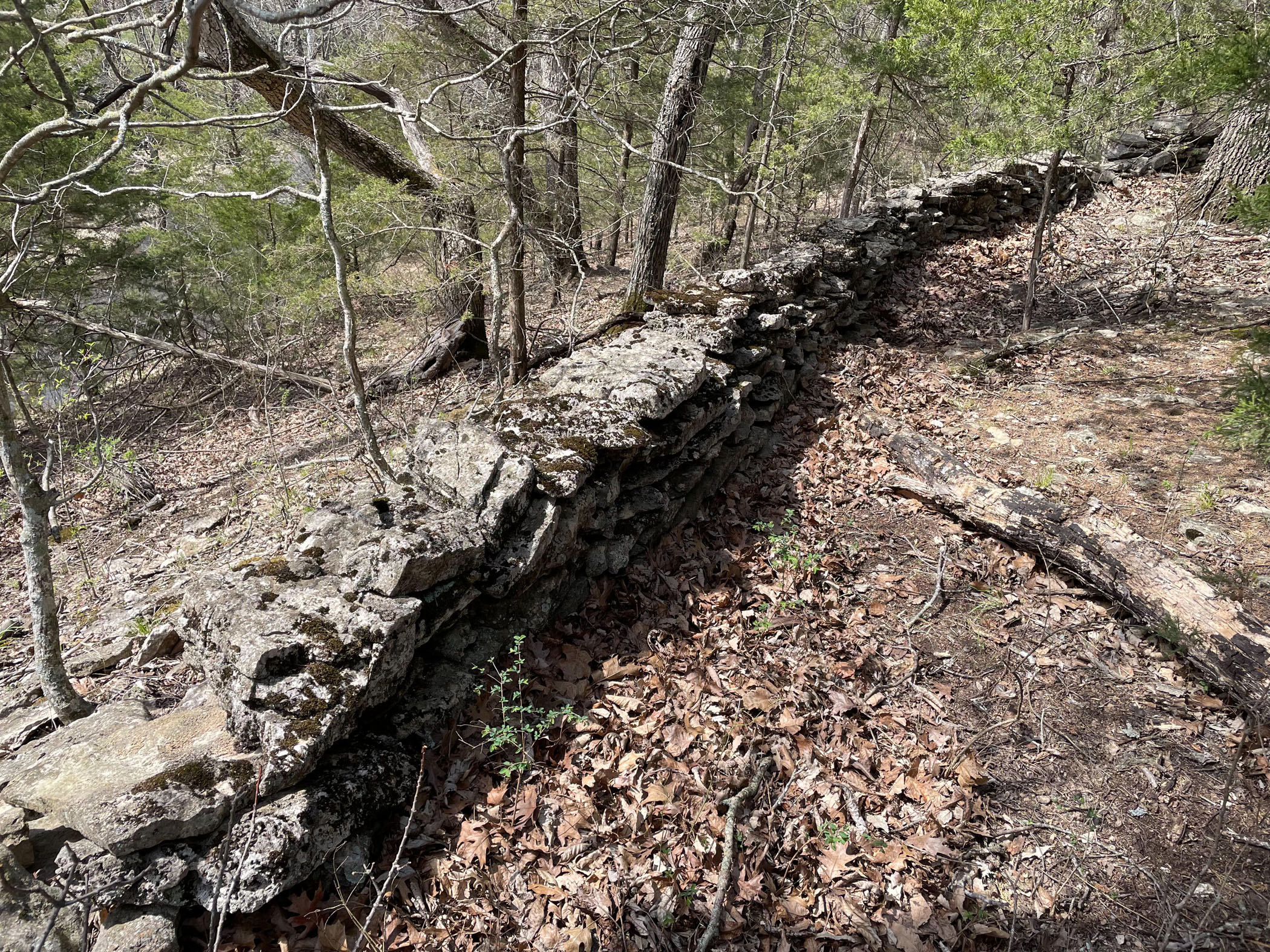
When I thought about the oldest story, which was the prompt for this week, I thought of stories of long ago, stories we had known the longest, the oldest ancestor in a family, the person who lived to be the oldest, and more. I finally settled on something much closer to home . . . the oldest man-made feature on the property where I grew up.
Growing Up
As kids, my sister, cousins, and friends explored the natural wonders of the property where I grew up. The creek, big boulders along the bluff, and the cave provided endless entertainment. It seems there were a lot less ticks, snakes, and other critters in that pasture back in those days. Yet, the little mom knew about our exploration still probably made my her nervous as a cat.
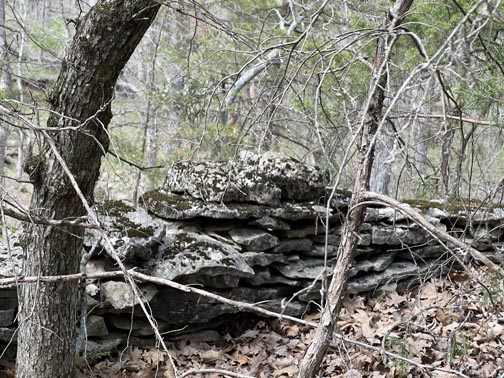
The Wall
One place that my sister and I never explored, most likely because we didn’t know that it existed until we were older, was an old rock wall. It sits at the top of the bluff on the far side of the creek. The wall is made of large flat stones piled on each other with apparently nothing, but gravity, holding them in place. A majority of the wall appears to still be in place today.
Dad said that the wall was the location of an old sawmill. It is unclear how the wall was used. It might have been used to keep logs from rolling down the bluff into the creek. Alternately, it might have been to keep humans from accidentally stepping off the edge of the bluff.
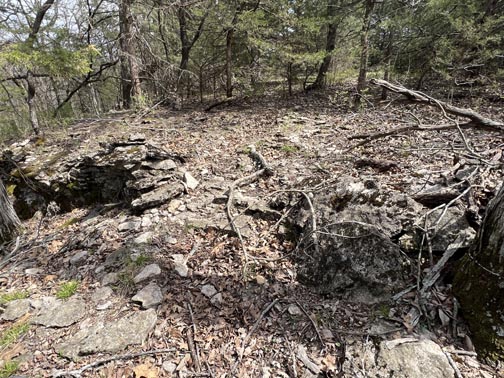
The Path To the Creek
Toward the north end of the wall, a clearly intentional opening in the wall exists. Through it is a path down toward the creek. It is in an area where the creek is more accessible than many other spots. It would have been good for accessing water.
Along the path, there are a couple of places where it appears that rocks in the side of the bluff were chiseled or cut to make rudimentary steps. This made walking up and down the path easier than climbing over big rocks.
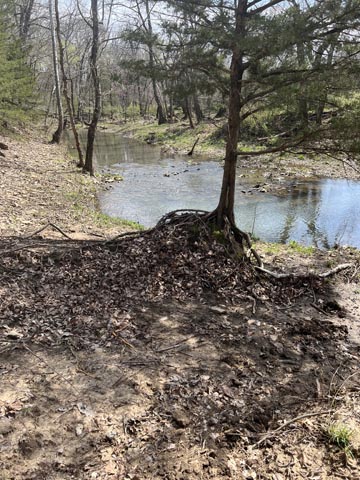
Location of the Mill
It is possible that the saw mill was down near the creek. However, even on the highest spots down near the river, the sawmill would have been easily washed away in floods. Additionally, it would not seem likely that they would have wanted to carry the lumber up the bluff. And, if so, what would the purpose of the wall have been?
It seems more likely that the sawmill stood on the top of the bluff. It might have stood just east of the wall. Trees now cover that area. However, it may have stood a bit further east in a larger, open area covered with flat-ish rocks. Some of the rocks are a part of the rocky terrain. However, others appear to be loose or placed on top of the ground. The rocks don’t create a 100% solid surface, but are close enough together to have created a surface for wagons hauling lumber.
Rocks also appear to create a walking path to this area. It is possible that the rocks are just a part of nature. However, they don’t match rock patterns in other areas nearby. And, again, they appear intentional. Thus, we believe that rocks were added specifically to create the path and a work area.
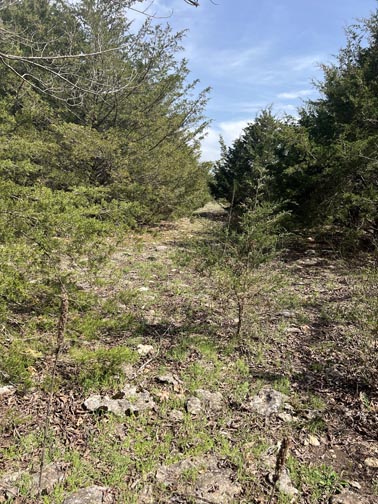
The Road
Coming from the rock open space is what appears to be a rock road heading east, although not completely straight. The road is covered with rocks in a similar way with trees and brush along the sides of the road. Again, it is possible that these rocks were somehow just randomly located in a way that appears to be a road. However, the rocks on the road, open space, and walking path are completely different than the big boulders and other rocks that dominate the landscape.
So, how old is it?
I don’t know exactly when the sawmill was built. It may likely have been built during the time the Missouri River, Fort Scott, and Gulf Railroad Company (later known as the Kansas City, Fort Scott, and Gulf Railroad company) owned the property, which would be the 1870s. And, it may have been built even earlier as investors led by James F. Joy of Michigan had obtained the property a few years earlier with the idea that it would be granted to the railroad.
In 1869, the railroad company hired almost all of the sawmills in the county, leaving the area with a shortage of lumber for building homes. Thus, it is likely the sawmill was used by the railroad. This is especially true since it was on property that the railroad was in the process of acquiring.
Next Oldest
The only other man-made structure on the property that rivals the wall in age, is the kitchen in the existing house. It once was a one-room house. It sat on a slightly raised area in the bottom below the bluff on the west side of the creek some distance from the sawmill. I believe that house was built in the late 1870s, which was while the land belonged to the railroad. It wasn’t until 1880 that it was officially sold to the Billman family. They also owned the property where Uncle Dewey lived.
This house was later moved up the bluff to its present location. However, I have no idea how they ever got it up the bluff with a team of horses. Sometimes getting a pickup loaded with hay or a wagon-load of hay up the bluff with a tractor was quite challenging.
If the house had been built on the same side of the creek as the saw mill, I might have assumed it was the family’s business. However, being on opposite sides means that is unlikely since there are times that crossing the river without a bridge would have been impossible. The closest sizeable bridge was on the road north of the property. Traveling from down by the river up to the road, across the bridge, and back to the sawmill would have been quite a trek. The only other bridge across the bridge at the time at the time was a foot bridge south of where the house sat, although I don’t know exactly where it was located.
Another Pre-Dates 1900
The last man-made feature of the property that pre-dates 1900 is the dining room on the house. It was built sometime in the 1880s. I am not sure exactly where it sat, but it was in the general area of the current house.
The Exact Location
If you get the idea that you might try to go find the wall and road, I will warn you that if you don’t know where it is, you likely won’t find it. Also, reaching it is going to require a lot of difficult walking, including climbing bluffs and over rocks while fighting thorn-covered trees and brush.